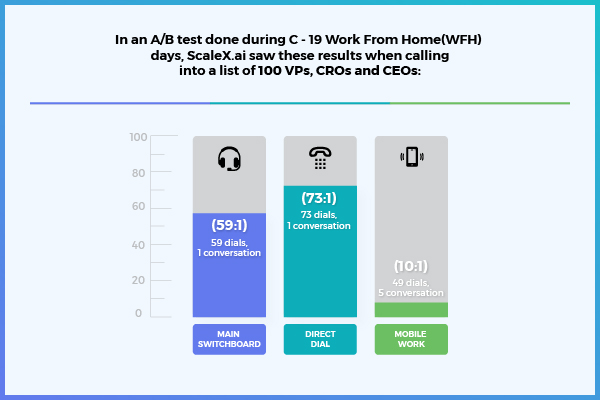Good to know that you don’t think telemarketing is a sales approach for dinosaurs. And that’s why you are here.
Telemarketing is, after all, a full, thriving industry. They would not have over 8,850 telemarketing firms with over half a million people if there were any traces of it being a non-valuable approach. Businesses still generate leads and revenue by picking up the phone and calling a prospect.
The only thing that has changed is the way telemarketers approach. With the introduction of AI, digital platforms, and data intelligence, telemarketers make every call count.
Here are ten B2B telemarketing tips telemarketers are following to set more appointments:
1. Don’t Sound Like a Script
Do you know why only a few telemarketers stand out from the crowd and get the response from the other end? They go through the same training process, they sell the same product, they probably have the same tools as you. What drives the engagement for them?
They don’t sound like script readers. They don’t just start the script from the moment the receiver picks up the phone. They make the person at the other end get involved in a conversation. And this is what makes the difference.
You don’t need to and shouldn’t follow the script as it is. Consider your script as a guide to keep your conversation on track. So, keep the script for your reference, but keep the conversation natural and engaging.
2. Be Proactive to Maintain the Engagement
It is easy to get carried away with a conversation where you may overcommit to keep your prospect engaged and take the topic beyond where you have knowledge or authority to continue the conversation.
Consider a situation. The person at the other end asks you to go deeper into something you have overcommitted about, and then there’s a long pause from your end. This happens with most of the telemarketers, especially rookie ones. So, first, avoid getting into any commitment that you are not fully aware of.
Second, when you are not sure about something, you need a proactive way to kill the pause. You can get your senior on the call or ask your prospect for a convenient time slot to schedule a call with your senior or you after you’ve done your research. Doing this will help you build trust. This trust at the initial stage will have higher chances of converting the prospects into customers.
Remember, all that your potential client wants is a solution provider who is genuine, proactive, and maintains transparency.
3. Figure Out What Floats Your Prospect’s Boat
Ask yourself some questions before calling. Why should they bother to talk to you in the first place? What do you have that they don’t have that can’t do themselves? If they already have a supplier for what you provide, why would they use you?
You’ll get better results if you answer those questions. Don’t wing it and make something up on the fly. While scripts may seem stilted, you must be consistent on why you’re calling and what the prospect stands to gain. As a result, do some research on potential problems and incorporate them into your rationale for calling to immediately engage the customer.
Leverage Reliable Data and Analysis
A productive telemarketing call is different from a routine call where a telemarketer just picks up the phone, dials, and finishes the call after asking a fixed set of questions. A smart telemarketer will ensure that he collects all the required data beforehand that will support their pitching during the call.
Data drives productive communication for telemarketers and builds trust with prospects. On the other hand, inaccurate data can mislead the call and might end up creating a terrible experience for the prospect.
If you want to get the best results from your telemarketing activities, the data given to your dialers must be checked, vetted, and reliable. For performance, it’s also essential to have a reliable data partner.
If your reps struggle with wrong numbers, misdials, and misinformation about contacts, or lack any useful contact data, consider a new data provider. SalesIntel provides 95% accurate human-verified B2B data which is reverified every 90 days to avoid data decay.
5. Learn from the Classic Mistakes
The best of the best have figured out how to use their errors to their advantage. Mistakes teach us what didn’t work and help us grow.
Take a look at the 9 most common telemarketing errors to help you avoid making them in the first place:
- Weak introductions
- Pitching instead of conversing
- Not paying attention to the customer
- Reading rigid scripts
- Lack of prior research
- Ignoring the primary objective
- Ignoring customer dissatisfaction
- Abandoning control of the conversation
- Failure to secure commitment
6. Integrate Artificial Intelligence (AI)
To become more competitive in communicating with prospects, more and more telemarketing operations are adapting and aggressively using AI. With the influx of huge data sets, AI will help you gain a competitive advantage.
One of AI’s biggest benefits is the ability to sift through piles of data and pre-qualify, sort, and hand out leads. Since prospects want to speak with live human agents, AI can dramatically improve your inbound operations by sorting leads and routing them to agents who are familiar with them. For outbound activities, AI can provide comprehensive data about the prospective client to the telemarketers.
7. Don’t Limit Your Research to Demographic Data
Let’s say you know you are calling the decision-maker. You want to make sure that every second counts. To do that, you need to go beyond knowing their name and job title. You want to already know they’re a good fit, so you can skip the basic prospecting questions and instead start the sales conversation.
You want to spend more time calling prospects who match your ideal customer profile. Widening your research with firmographic and technographic data will not only help you to drive a productive conversation but will also help you to prioritize your calls. Thus, limiting your research and data collection approach to demographic data also limits your sales opportunities.
8. Make Sure You Have a Follow-Up Plan
There are four key things to remember when ensuring a follow-up:
- Obtain a Promise (a specific day and time)
- Arrive on Time (not early, not late, on time)
- Renew Their Memories (remind them of your name and business and briefly state what you discussed on the last call or email)
- Don’t Bother the Prospect (give them time and don’t pressure them into making a decision).
- Plan for the Future (if they decline to move the sale forward, set a far future follow-up reminder to give the situation time to change)
9. Avoid the Gatekeeper
Receptionists are often instructed to avoid routing calls to managers or executives. They are also told not to give out personal information over the phone. On average, it takes 22 minutes to connect using switchboard numbers but just five minutes to connect with direct dial numbers. So, it is better to bypass the gatekeeper and reach the decision-makers on their work mobile number.
ScaleX research compared the efficiency of dialing switchboards, direct desk numbers, and direct-work mobile numbers from SalesIntel. Of all the three ways to call your prospects, and direct-work mobile numbers are the most productive.

According to their research, the Dial-to-Connect Ratio (DCR) for work mobile numbers from SalesIntel, was 10:1. That’s a 7X higher DCR than direct dial desk phones and 6X for switchboards. Taking the extra time and investment to get mobile numbers pays off.
10. Avoid Being Blocked or Flagged
Consumers often report the phone numbers of legitimate companies because they are irritated. Perhaps you interrupted them, or your call center dialed them at an inopportune time. Some people will even report numbers that they are unfamiliar with since it might be a scam if they don’t recognize the phone number.
Although you don’t have complete control over whether your calls are flagged or blocked, you can employ several tactics to make it easier for you to reach customers.
- Use Caller ID Reputation to scan numbers for flags when you buy a list. It will help you clean the list as a previous owner might have misused it.
- Keep track of your numbers daily to catch any red flags early.
- Follow ethical rules that will not irritate customers as restrictions on call timing and repetition.
- Don’t be afraid of leaving voicemails.
Final Thoughts – Do it Right
When it comes to telemarketing, there is an art to it. These pointers will get you most of the way to success, but there are a few other things to consider, such as where you get your call list.
Use a reliable source of data. Want to know how accurate and up-to-date data can make a difference to your telemarketing approach?
Try SalesIntel, and test our data range and accuracy before buying.





